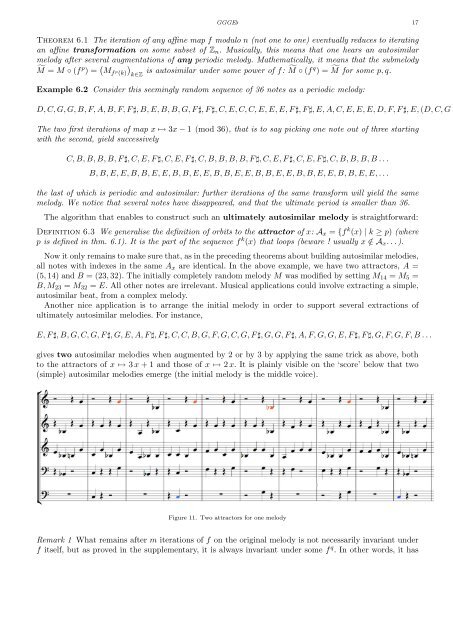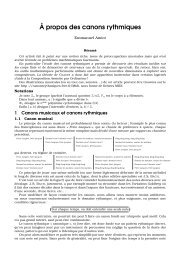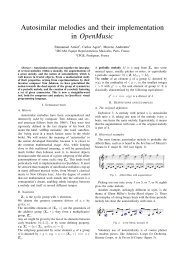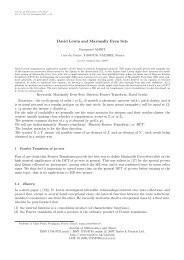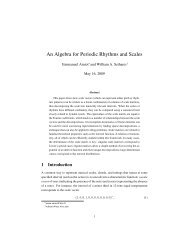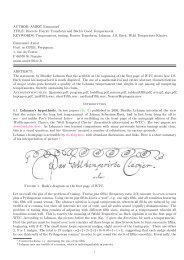Emmanuel Amiot Modèles algébriques et algorithmes pour la ...
Emmanuel Amiot Modèles algébriques et algorithmes pour la ...
Emmanuel Amiot Modèles algébriques et algorithmes pour la ...
You also want an ePaper? Increase the reach of your titles
YUMPU automatically turns print PDFs into web optimized ePapers that Google loves.
GGGE♭ 17<br />
Theorem 6.1 The iteration of any affine map f modulo n (not one to one) eventually reduces to iterating<br />
an affine transformation on some subs<strong>et</strong> of Zn. Musically, this means that one hears an autosimi<strong>la</strong>r<br />
melody after several augmentations of any periodic melody. Mathematically, it means that the submelody<br />
M = M ◦ (f p ) = <br />
Mf p (k) k∈Z is autosimi<strong>la</strong>r under some power of f: M ◦ (f q ) = M for some p, q.<br />
Example 6.2 Consider this seemingly random sequence of 36 notes as a periodic melody:<br />
D, C, G, G, B, F, A, B, F, F ♯, B, E, B, B, G, F ♯, F ♯, C, E, C, C, E, E, E, F ♯, F ♯, E, A, C, E, E, E, D, F, F ♯, E, (D, C, G .<br />
The two first iterations of map x ↦→ 3x − 1 (mod 36), that is to say picking one note out of three starting<br />
with the second, yield successively<br />
C, B, B, B, B, F ♯, C, E, F ♯, C, E, F ♯, C, B, B, B, B, F ♯, C, E, F ♯, C, E, F ♯, C, B, B, B, B . . .<br />
B, B, E, E, B, B, E, E, B, B, E, E, B, B, E, E, B, B, E, E, B, B, E, E, B, B, E, E, . . .<br />
the <strong>la</strong>st of which is periodic and autosimi<strong>la</strong>r: further iterations of the same transform will yield the same<br />
melody. We notice that several notes have disappeared, and that the ultimate period is smaller than 36.<br />
The algorithm that enables to construct such an ultimately autosimi<strong>la</strong>r melody is straightforward:<br />
Definition 6.3 We generalise the definition of orbits to the attractor of x: Ax = {f k (x) | k ≥ p) (where<br />
p is defined in thm. 6.1). It is the part of the sequence f k (x) that loops (beware ! usually x /∈ Ax. . . ).<br />
Now it only remains to make sure that, as in the preceding theorems about building autosimi<strong>la</strong>r melodies,<br />
all notes with indexes in the same Ax are identical. In the above example, we have two attractors, A =<br />
(5, 14) and B = (23, 32). The initially compl<strong>et</strong>ely random melody M was modified by s<strong>et</strong>ting M14 = M5 =<br />
B, M23 = M32 = E. All other notes are irrelevant. Musical applications could involve extracting a simple,<br />
autosimi<strong>la</strong>r beat, from a complex melody.<br />
Another nice application is to arrange the initial melody in order to support several extractions of<br />
ultimately autosimi<strong>la</strong>r melodies. For instance,<br />
E, F ♯, B, G, C, G, F ♯, G, E, A, F ♯, F ♯, C, C, B, G, F, G, C, G, F ♯, G, G, F ♯, A, F, G, G, E, F ♯, F ♯, G, F, G, F, B . . .<br />
gives two autosimi<strong>la</strong>r melodies when augmented by 2 or by 3 by applying the same trick as above, both<br />
to the attractors of x ↦→ 3 x + 1 and those of x ↦→ 2 x. It is p<strong>la</strong>inly visible on the ‘score’ below that two<br />
(simple) autosimi<strong>la</strong>r melodies emerge (the initial melody is the middle voice).<br />
Figure 11. Two attractors for one melody<br />
Remark 1 What remains after m iterations of f on the original melody is not necessarily invariant under<br />
f itself, but as proved in the supplementary, it is always invariant under some f q . In other words, it has


